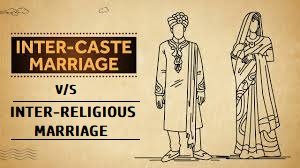Intercaste marriages, especially between castes that have achieved socio-economic parity, have increased in India, but interreligious marriages remain relatively rare. This contrast reflects deeper social, cultural, and religious dynamics in Indian society.
Increase in Intercaste Marriages:
- Socio-economic Parity:
- Caste-based hierarchies are deeply rooted in India, but as education, urbanization, and economic development have progressed, individuals from different castes with similar socio-economic status find themselves in shared spaces such as workplaces, colleges, and social settings.
- This shared socio-economic status has helped bridge traditional caste divides to some extent. When individuals have similar educational qualifications, professional status, and financial backgrounds, their caste identities may become less significant, facilitating intercaste marriages.
- Urbanization and Modernization:
- Urbanization and modernization have played a major role in changing attitudes toward caste. In urban areas, caste identity is less visible, and individuals are more likely to interact with people from different castes. This has fostered an environment where intercaste marriages are more socially acceptable, particularly among the educated middle class.
- Legal and Social Support:
- India’s Special Marriage Act (1954) provides legal backing for intercaste marriages, which protects couples from potential opposition. Additionally, initiatives like government schemes offering incentives for intercaste marriages (e.g., between upper-caste and Scheduled Caste individuals) further encourage such unions.
- Caste Mobility:
- Caste mobility through education and economic success has weakened some caste boundaries. Individuals from lower castes who achieve economic success are often perceived as more acceptable marriage partners, as caste hierarchies have become less rigid in some cases.
Limited Increase in Interreligious Marriages:
- Religious Conservatism:
- Religion, unlike caste, is a more rigid identity marker, deeply intertwined with personal beliefs, cultural practices, and community identities. Marriages across religious boundaries are often seen as a challenge to the fundamental religious and social norms of both communities.
- Religious groups, especially conservative elements, often resist interreligious unions due to fears of religious conversion, loss of identity, or dilution of traditions.
- Family and Community Opposition:
- In many cases, family and community pressure against interreligious marriages is far more intense than against intercaste marriages. Interreligious marriages are seen as disrupting religious continuity, and families may perceive such unions as a betrayal of their faith and cultural heritage.
- Honor-based violence and social ostracization are still common responses to interreligious marriages, particularly in rural and traditional communities.
- Legal and Political Challenges:
- Interreligious marriages face additional hurdles because of the legal and political landscape in India. While the Special Marriage Act allows for interreligious marriages without conversion, couples often face bureaucratic delays and public scrutiny.
- Politically, the narrative of “Love Jihad”—a conspiracy theory that alleges that Muslim men marry non-Muslim women to convert them—has further stigmatized interreligious marriages, particularly between Hindus and Muslims. This political rhetoric has polarized communities and reinforced resistance to such unions.
- Cultural and Religious Differences:
- Interreligious marriages often involve navigating complex differences in rituals, dietary habits, festivals, and child-rearing practices. These cultural differences can create tension, making families less supportive of such unions. For instance, Hindu-Muslim marriages, in particular, face challenges due to the historical and political tensions between the two communities in India.
- Lack of Socio-religious Parity:
- While caste-based parity is growing, religious communities often do not share similar levels of socio-religious integration. Many people still marry within their religious communities because of shared beliefs, values, and cultural practices, and religious endogamy is widely encouraged. Interreligious marriages, therefore, tend to remain uncommon.
Conclusion:
The increase in intercaste marriages between castes with socio-economic parity reflects modernization, urbanization, and the weakening of traditional caste boundaries. However, interreligious marriages continue to face significant barriers due to religious conservatism, social pressures, and political challenges. While intercaste marriages suggest a shift in societal attitudes toward caste, religious identity remains a more deeply entrenched and sensitive issue in Indian society, limiting the spread of interreligious unions.


